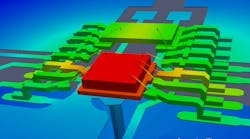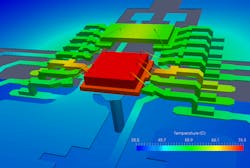Earlier this year, Cadence introduced the Clarity 3D Solver, a 3D electromagnetic (EM) field solver for printed-circuit-board (PCB) and integrated-circuit (IC) package design. Following up on that, Cadence recently unveiled the Celsius Thermal Solver, which the company says is the first complete electrical-thermal co-simulation solution for electronic systems (see figure). Continuing what the Clarity 3D Solver began, the Celsius Thermal Solver is the second product in what Cadence calls its new system analysis initiative.
Cadence maintains that next-generation designs require a new electrical-thermal co-simulation solution. CT Kao, product management director at Cadence, provides some background information concerning this topic. “Electrical performance and thermal profiles are interwoven together,” he says. “A system’s electrical performance will depend on the thermal response. Electrical resistance and power dissipation will be affected by temperature. The temperature profile will impact the electronic system’s functionality. Sometimes it will even cause failure if there are unwanted hotspots.”
With both transient and steady-state analysis, Cadence maintains that Celsius Thermal Solver delivers accurate electrical-thermal co-simulation.
Kao continues, “The thermal profile will be affected by electrical behavior because currents traveling through resistance will introduce an additional heat source. In some cases, high-current surges can arise that can cause local hotspots and result in damage. So, electrical and thermal analysis must be performed together. That’s why we want to address these challenges and provide a unified tool.”
On top of that, Kao points out that transient simulation is critical in electronic design, with a main reason being multiple operational modes. “Take a smartphone, for example,” he says. “You’re watching videos, listening to audio, and browsing the web—but not at the same time. All of the power has to be turned on and off to satisfy the user needs. The power scheme and the power profile have to be time-varying. That introduces difficulties in the analysis and simulation.”
The Answer: Celsius Thermal Solver
Cadence believes that the solution to today’s thermal analysis challenges lies in its new Celsius Thermal Solver tool, which enables iterative electrical-thermal co-simulation at the IC, package/PCB, and system levels.
At the IC level, the Celsius Thermal Solver tool allows for analysis within the chip. It addresses 3D-ICs, die-to-die bonding, and through-silicon vias (TSVs). At the package/PCB level, the tool features finite-element-analysis (FEA) and computational-fluid-dynamics (CFD) techniques for both transient and steady-state simulation. Furthermore, the capabilities of Celsius Thermal Solver extend beyond packages/PCBs—the tool also delivers a system-centric approach by including objects like heat sinks, enclosures, etc.
The Celsius Thermal Solver is based on a massively parallel architecture that delivers significantly faster performance than legacy solutions, according to Cadence. It also integrates with various Cadence design platforms, such as Virtuoso and Allegro.


